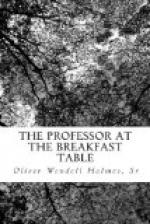The young man John, for instance, asked me to come up one day and try some “old Burbon,” which he said was A 1. On asking him what was the number of his room, he answered, that it was forty-’leven, sky-parlor floor, but that I shouldn’t find it, if he did n’t go ahead to show me the way. I followed him to his habitat, being very willing to see in what kind of warren he burrowed, and thinking I might pick up something about the boarders who had excited my curiosity.
Mighty close quarters they were where the young man John bestowed himself and his furniture; this last consisting of a bed, a chair, a bureau, a trunk, and numerous pegs with coats and “pants” and “vests,”—as he was in the habit of calling waist-coats and pantaloons or trousers,—hanging up as if the owner had melted out of them. Several prints were pinned up unframed,—among them that grand national portrait-piece, “Barnum presenting Ossian E. Dodge to Jenny Lind,” and a picture of a famous trot, in which I admired anew the cabalistic air of that imposing array of expressions, and especially the Italicized word, “Dan Mace names b. h. Major Slocum,” and “Hiram Woodruff names g. m. Lady Smith.” “Best three in five. Time: 2.40, 2.46, 2.50.”
That set me thinking how very odd this matter of trotting horses is, as an index of the mathematical exactness of the laws of living mechanism. I saw Lady Suffolk trot a mile in 2.26. Flora Temple has trotted close down to 2.20; and Ethan Allen in 2.25, or less. Many horses have trotted their mile under 2.30; none that I remember in public as low down as 2.20. From five to ten seconds, then, in about a hundred and sixty is the whole range of the maxima of the present race of trotting horses. The same thing is seen in the running of men. Many can run a mile in five minutes; but when one comes to the fractions below, they taper down until somewhere about 4.30 the maximum is reached. Averages of masses have been studied more than averages of maxima and minima. We know from the Registrar-General’s Reports, that a certain number of children—say from one to two dozen—die every year in England from drinking hot water out of spouts of teakettles. We know, that, among suicides, women and men past a certain age almost never use fire-arms. A woman who has made up her mind to die is still afraid of a pistol or a gun. Or is it that the explosion would derange her costume?
I say, averages of masses we have, but our tables of maxima we owe to the sporting men more than to the philosophers. The lesson their experience teaches is, that Nature makes no leaps,—does nothing per saltum. The greatest brain that ever lived, no doubt, was only a small fraction of an idea ahead of the second best. Just look at the chess-players. Leaving out the phenomenal exceptions, the nice shades that separate the skilful ones show how closely their brains approximate,—almost as closely as chronometers. Such a person is




